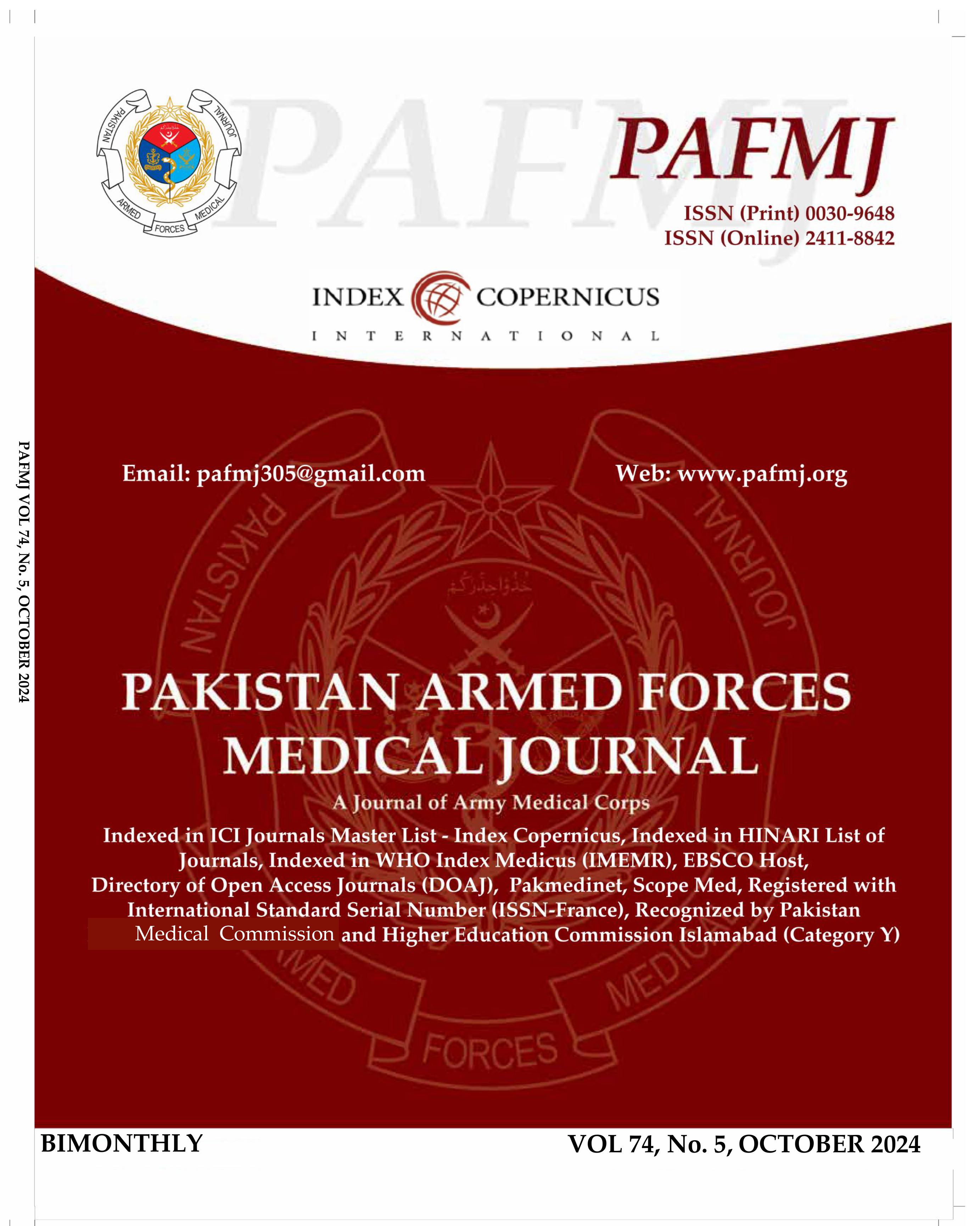Children with Developmental Dysplasia of Hip - Our Experience of Outcome at a Tertiary Care Centre
DOI:
https://doi.org/10.51253/pafmj.v74i5.8082Keywords:
Osteotomy, Single-stage, Triple procedure.Abstract
Objective: To assess the operative outcome of children who underwent surgical management for developmental dysplasia hip at a tertiary care center.
Study Design: Case series.
Place and Duration of Study: Pak-Emirates Military Hospital, Rawalpindi Pakistan, from Jan to Oct 2021.
Methodology: This case series included 25 children who underwent triple procedure encompassing open reduction, femoral shortening and Salter’s pelvic osteotomy. Post-operative analysis of the clinical outcome was done using McKay’s classification and radiological assessment done using Severin’s classification.
Results: Age of enrolled participants ranged from 02 to 07 years, mean age being 4.3±1.45 years, of which 8(32%) were male and 17(68%) were female. Mean pre-operative acetabular index was 40.3±3.38 while the mean post-operative acetabular index was 25.1±3.10. On follow-up, one child had subluxation while another had complete dislocation of the hip joint.
Conclusion: Triple procedure with open reduction, femoral shortening and Salter’s osteotomy gives satisfactory results in patients aged 2 to 7 with substantial reduction in post-operative acetabular index.
Downloads
References
Lee MC, Eberson CP. Growth and development of the child’s hip. Orthop Clin N Am 2006; 37: 119-132.
Kolb A, Chiari C, Schreiner M, Heisinger S, Willegger M, Rettl G, et al. Development of an electronic navigation system for elimination of examiner-dependent factors in the ultrasound screening for developmental dysplasia of the hip in newborns. Sci Rep 2020; 10(1): 16407.
https://doi.org/10.1038/s41598-020-73253-6
Litrenta J, Masrouha K, Wasterlain A, Castaneda P. Ultrasound Evaluation of Pediatric Orthopaedic Patients. J Am Acad Orthop Surg 2020; 28(16): e696-e705.
Hauk L. Developmental Dysplasia of the Hip in Infants: A Clinical Report from the AAP on Evaluation and Referral. Am Fam Physician 2017; 96(3): 196-197.
Gornitzky AL, Georgiadis AG, Seeley MA, Horn BD, Sankar WN. Does Perfusion MRI After Closed Reduction of Developmental Dysplasia of the Hip Reduce the Incidence of Avascular Necrosis? Clin Orthop Relat Res 2016; 474(5): 1153-1165.
https://doi.org/10.1007/s11999-016-4712-0
Schaeffer E, Lubicky J, Mulpuri K. AAOS Appropriate Use Criteria: The Management of Developmental Dysplasia of the Hip in Infants up to Six Months of Age: Intended for Use by Orthopaedic Specialists. J Am Acad Orthop Surg 2019; 27(8): e369-e372.
El-Sayed MM, Hegazy M, Abdelatif NM, ElGebeily MA, ElSobky T, Nader S. Dega osteotomy for the management of developmental dysplasia of the hip in children aged 2-8 years: results of 58 consecutive osteotomies after 13-25 years of follow-up. J Child Orthop 2015; 9: 191-198.
https://doi.org/10.1007/s11832-015-0654-6
Shaw BA, Segal LS. Evaluation and referral for developmental dysplasia of the hip in infants. Pediatrics 2016; 138(6): e20163107.
https://doi.org/10.1542/peds.2016-3107
Yang S, Zusman N, Lieberman E. Developmental dysplasia of the hip. Pediatrics 2019; 143(1): e20181147.
https://doi.org/10.1542/peds.2018-1147
Madhu TS, Akula M, Scott BW, Templeton PA. Treatment of developmental dislocation of hip: does changing the hip abduction angle in the hip spica affect the rate of avascular necrosis of the femoral head? J Pediatr Orthop B 2013; 22(3): 184-188. https://doi.org/10.1097/BPB.0b013e32835e3646
Swarup I, Penny CL, Dodwell ER. Developmental dysplasia of the hip: an update on diagnosis and management from birth to 6 months. Curr Opin Pediatr 2018; 30: 84-92.
https://doi.org/10.1097/MOP.0000000000000578
Murgai RR, Harris LR, Choi PD. Socioeconomic risk factors for poor outcomes of developmental dysplasia of the hip. J Pediatr 2019; 211: 159-163.
https://doi.org/10.1016/j.jpeds.2019.03.015
Sankar WN, Gornitzky AL, Clarke NMP. Closed reduction for developmental dysplasia of the hip: early-term results from a prospective, multicenter cohort. J Pediatr Orthop 2019; 39: 111-118. https://doi.org/10.1097/BPO.0000000000001164
Balioglu MB, Oner A, Aykut US, Kaygusuz MA. Mid term results of Pemberton pericapsular osteotomy. Indian J Orthop 2015; 49(4): 418-424. https://doi.org/10.4103/0019-5413.159654
McKay DW. A comparison of the innominate and the pericapsular osteotomy in the treatment of congenital dislocation of the hip. Clin Orthop Relat Res 1974; (98): 124-132.
Severin E. Congenital dislocation of the hip; development of the joint after closed reduction. J Bone Joint Surg Am 1950; 32-A(3): 507-518. https://doi.org/10.2106/00004623-195032030-00002
Saqib M, Salman M, Hayat S. Developmental dysplasia of the hip in older children. J Ayub Med Coll Abbottabad 2019; 31(3): 433-436.
Vallamshetla VR, Mughal E, O’Hara JN. Congenital dislocation of the hip. A re-appraisal of the upper age limit for treatment. J Bone Joint Surg Br 2006; 88: 1076-1081.
https://doi.org/10.1302/0301-620X.88B8.17469
Umer M, Nawaz H, Kasi P, Ahmed M. Outcome of triple procedure in older children with developmental dysplasia of hip (DDH). JPMA 2007; 57(12): 591-595.
Ganger R, Radler C, Petje G, Manner HM, Kriegs-Au G, Grill F. Treatment options for developmental dislocation of the hip after walking age. J Pediatr Orthop B 2005; 14(3): 139-150.
https://doi.org/10.1097/01202412-200505000-00004
Abdullah EA, Razzak MY, Hussein HTK, El-Adwar KL, Youssef AA. Evaluation of the results of operative treatment of hip dysplasia in children after the walking age. Alex J Med 2012; 48(2): 115-122. https://doi.org/10.1016/j.ajme.2012.02.004
Ning B, Yuan Y, Yao J, Zhang S, Sun J. Analyses of outcomes of one-stage operation for treatment of late-diagnosed developmental dislocation of the hip: 864 hips followed for 3.2 to 8.9 years. BMC Musculoskelet Disord 2014; 15: 401.
https://doi.org/10.1186/1471-2474-15-401
Bhuyan BK. Outcome of one-stage treatment of developmental dysplasia of hip in older children. Indian J Orthop 2012; 46: 548-555.
Downloads
Published
Issue
Section
License
Copyright (c) 2024 Mian Qaisar Ali Shah, Rizwana Bashir Kiani, Asrar Ahmad, Hamza Ali Malik, Javed Ur Rehman, Zahid Anwar

This work is licensed under a Creative Commons Attribution-NonCommercial 4.0 International License.















